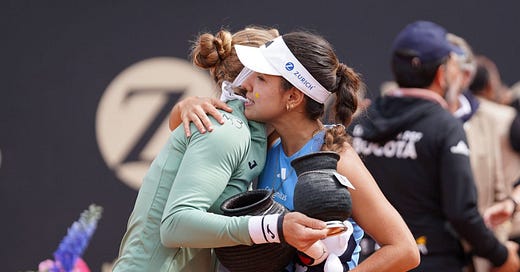Bouzkova vs Osorio: Bogotá Final Analysis (WTA 250)
Down-the-line strikes and mastery of long rallies in the 2nd set tiebreak.
cover 📸 credit: Copa Colsanitas Zurich twitter
At 2,640 meters (or 8,660 ft) above sea level, Bogotá stands as the highest stop on the WTA Tour. Once again, it lifted the passion and joy of Colombian tennis fans to sky-high levels.
Home favourite Camila Osorio, the 2021 Bogotá winner, overcame second-seed and defending 2-times champion Tatjana Maria in the quarterfinals (ending Maria’s streak of 14 wins in Bogotá), before completing the “full-circle” by defeating top-seed Marie Bouzkova in the final.
Victory gave Osorio a second WTA Tour title and was the perfect comeback following her 2023 absence due to injury. In 26 editions of the Colombian tournament, a home player has been crowned 7 times (Fabiola Zuluaga in 1999, 2002, 2003, 2004, Mariana Duque in 2010 and Osorio’s 2 wins).
Despite the disappointing result, Bouzkova extended her streak of consecutive seasons reaching a WTA Tour final to 5. While a home win in Prague (2022) remains her only title thus far, she keeps getting close.

Major factors that decided the Bogotá final:
Down-the-line winners (and forcing shots)
Backhand performance
Baseline superiority
Long rallies
1. Down-the-line winners (and forcing shots)
Osorio hit 26 winners on returns and rally shots, 11 more than Bouzkova’s total of 15 winners. It was the difference in the match.
With 14 winners hit down the line, Osorio made most of the damage on parallel shots.
Osorio’s forehand winners were more frequently directed towards the backhand corner of Bouzkova (10 of 16), as shown below by the black circle with arrow. While that number includes some inside-out forehand winners, a clearer view is provided by backhand data.

Osorio struck 10 backhand winners; 9 were down-the-line shots sent towards Bouzkova’s forehand corner (black circle with arrow, below).

The impact of Osorio’s down-the-line shots is even more significant when we combine winners and forcing shots (referred as winning shots).
Osorio hit a staggering 24 down-the-line winning shots. These were high-efficiency drives, as she only committed 8 down-the-line unforced errors.
In contrast, Bouzkova hit most of her winning shots crosscourt (16 crosscourt winning shots). She was most efficient on crosscourt forehand attempts, finishing with 10 winning shots to 3 unforced errors.

2. Backhand performance
With a total of 16 winners, Osorio’s forehand was the most prolific shot of the match. However, most of the difference was set by backhand performances.
Forehand performance
Bouzkova: 11 winners / 18 errors = -7
Osorio: 16 winning shots / 24 errors = -8
Backhand performance
Bouzkova: 4 winners / 29 errors = -25
Osorio: 10 winners / 23 errors = -13
Bouzkova finished with 29 backhand errors. This was particularly costly because her backhand only produced 4 winners, 6 less than Osorio. Overall, it resulted in a 12-point advantage for Osorio.
3. Baseline superiority
Osorio turned a better groundstroke performance into baseline superiority.
She won 54% of baseline points (57/105) and limited Bouzkova to a 43% baseline win-rate (40/93).
Bouzkova attacked the net on 19 occasions. It netted better results than staying back, but the win percentage was a relatively low 53% (10/19).
4. Long rallies
In a clash between two players renowned for their all-out efforts, some long rallies were expected. The match featured 31 long points (i.e. reaching a 9th shot) which at 21% of all points played may be lower than anticipated by some.
Yet, long rallies provided plenty of separation and drama.
Osorio won 9 more points in the match. Most of it originated from long rallies: Osorio won 19 points and lost 12, for a 7-point edge.
At 5-6 40/A* in set 2, Bouzkova saved a match point by coming up with a passing shot winner to end a 14-shot rally.
The ensuing tiebreak featured 3 points lasting 9+ shots. All 3 were won by Osorio. The first levelled the score at 3-3 and erupted the crowd. The last one had Bouzkova scrambling from side to side before Osorio sentenced it with a 14th-shot forcing approach. It finished the match and brought the Colombians to their feet.
Confidence renewed, it will be interesting to see how far Camila Osorio can go with the increased aggression levels she showed during the Bogotá final.






